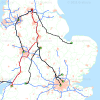Hydroscope software
A digital terrain model (DEM) provides a regularly-spaced grid of elevations above an absolute or relative datum over the terrain. Recent advances in techniques for measuring DEM from satellites and aircraft have significantly improved spatial resolution, spatial accuracy and accuracy and precision of measuring elevations. For example, LIDAR data covering local areas at large scales with vertical accuracies of +/-15 cm or countrywide elevations of +/-1 to 2 m are available in Great Britain.Hydroscope software reads DEM data in different formats. It builds a series of raster and vector layers and creates overland down-slope flow paths over a geographical area such as a river basin or catchment or country. It uses a unique algorithm for managing plateaux and sinks. The result is a comprehensive, topologically-checked network of flow-paths over the terrain surface of a study area.You can overlay thematic maps, remote sensing images and derived land-over images. You can perform functions to traverse the surface network and perform spatial analytical functions over the land surface such as measuring areas of grassland, heather and forests within a river catchment.One application is for capturing selected parameters for hydrological modelling of water run-off from river catchments. You can measure the areas of rocks, soils, land-cover types such as snow cover, grassland, peat, forests and scrub. You can measure elevations, slopes, slope proifiles, aspects, river catchment long profiles, catchment size, shape, length, breadth and perimeter length. You can classify the main and tributary drainage channels as first, second, third ... order, determine the bifurcation ratios of the river network. As you can repeatedly traverse the surface network, you can compute a braod range of parameters which are required for hydrological modelling and flood forecasting. And you can spatially correlate dilferent overlays such as surface geology, soils, land-cover types, slope, aspect, cumulative solar radiation inputs and derive measurements of the area of each type of results. Hydroscope software provides a neat way of performing terrain analysis for a variety of purposes including studies of the amount of carbon sequestered over the land surfaces in forests, woodlands, scrub and grasslands.Another application for Hydroscope is for analyzing the effects of climate change on carbon capture and storage over a study area. Hydroscope allows the import or creation of multiple map overlays. It facilitates spatial analysis by allow comparisions of multiple map layers or spatial analysis. For example, you can read in a digital elevation model, surface geology map, soil map, land cover / land use map, topographic map and derive a carbon capture and storage map. You can relate this to a series of climatic maps showing long term averages and changes in climate. The ease with which you can ascend and descend the topographic network facilitates spatial analysis and comparisons and aids understanding of features such as land cover / land use change.Hydroscope software has been tested using very large digital elevation models covering extensive areas in the Western United Seates using DEM from the US Geological Survey. Recent advances in technologies for capturing data about terrain elevations from satellite, aircraft and unmanned airborne vehicles, for example using RADAR and Lidar, have allowed the creation of DEM data with a grid spacing of less than one metre and elevations to within +/- 0.25m. These DEMs are being used for earth engineering works, such as monitoring the movement on sands on exposed coastal beaches and moving the sand to maintain the recreational amenity and quality of a beach.Hydroscope software provides a relatively straight-forward way of creating and displaying digital terrain models on computers running Microsoft Windows XP, Vista or 7 environments. It is flexible, reliable and robust. It handles very large digital terrain models and digital map overlays including vector and raster map data. FeaturesHydrological Analysis of TerrainReads a regularly-spaced grid of digital elevation data and allows you to build a surface network.Traverse Surface NetworkYou can traverse the surface network and collect information, derive parameters and measurements.Hydrological ParametersDerive parameters for hydrological modelling of rainfall run-off from a river catchmentSpatial AnalysisPerform spatial analysis over terrain surface to correlate land cover types, geology, soils, vegetation and snow cover.Climate ChangeMap and analyse carbon capture and storage using land cover from remote sensing, land use maps, digital elevation models and estimates of carbon release.Output reportsProvide a report on the output from the functions which have been used for terrain analysis
